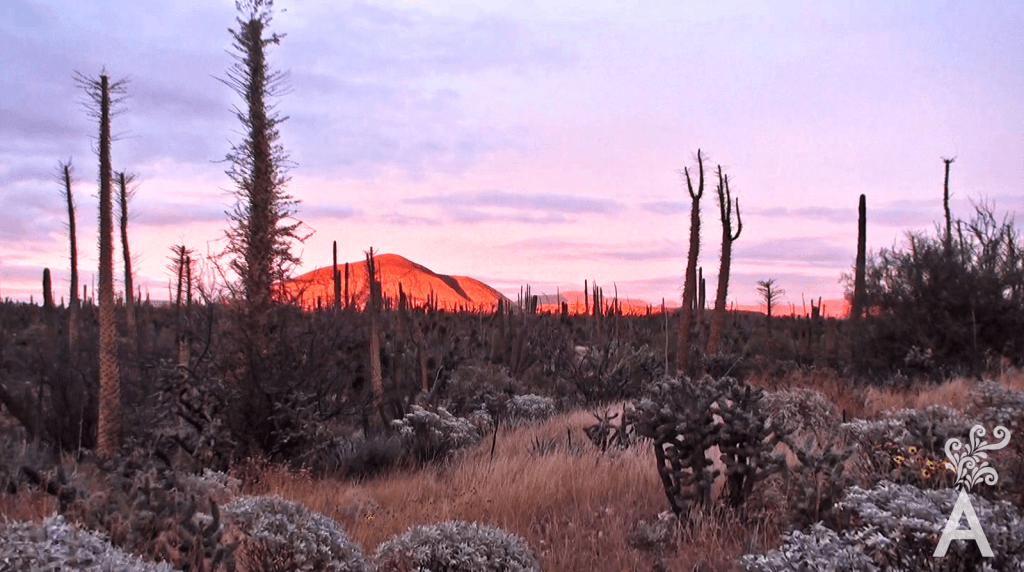[dropcap]A[/dropcap]bout halfway up the peninsula and just across the border between the states of Baja California Sur and Baja California, lies the entrance to one of the largest and best preserved of the 176 Protected Areas in Mexico, with more than 9,650 square miles: El Valle de los Cirios.
Everything started with a trip organized by the Ministry of the Environment and Natural Resources. The travelers included some of the most important international correspondents based in Mexico City. It was hoped that they might learn, live and spread the unique beauty of this special corner of our country.
We arrived at Guerrero Negro on a special flight aboard a Navy plane from La Paz. American visionary Daniel Ludwig came to Guerrero Negro in 1954. Ludwig developed tourism at the Tres Vidas Golf Beach near Acapulco and started what is now the world’s largest salt plant. Upon arrival, we waited with broad smiles while joined by employees of SEMARNAT and the Protected Areas of the State, including El Valle de los Cirios.

We jumped into several kinds of vans and left immediately in order to beat the impending darkness. After less than an hour, we were at the entrance of this impressive valley. Thousands and thousands of cacti arose everywhere in the desert. There were flowering teasels as well, but Boojum Trees were the dominant plant reaching heights of more than 45 feet. The Boojum Tree is a member of the Ocotillo cactus family. Boojum Trees here are renowned worldwide not only for their height but for the contortions of the tapered trunk and multiple branches.

We followed a dirt road and after less than two hours entered a forest of desert flora. Suddenly, we came across a mining ghost town known as the Campo o Pozo Aleman (Field, or German Well) dating back to the 19th century.
Everardo Melendez, a biologist who works with the National Commission of Natural Protected Areas (CONANP), described the history of this small town abandoned years ago.

“… The problem is not that much is known about this area. We apparently know that it housed a large group of people who settled in various caves. Surely these settlements included more than 100 or 200 people across this great complex…”
In the group was Benito Bermudez, CONANP Director in Baja California Sur and knowledgeable about this vast and desolate area of the middle peninsula. He explained this enigmatic place.
“… This town was populated by miners extracting gold and silver. There is a sedimentation area here for the input side and areas where they worked with pick and shovel to extract the precious metals … “
This authentic ghost town that was inhabited in the late 1800s is intriguing. There are caves dug under the small hills surrounding the location. Some two-story houses, built of brick, adobe and wooden doors, still stand but are completely abandoned. There is a picturesque small cemetery where, curiously, multi-colored artificial flowers at the foot of some of the white tombstones mingle with the contrasting shades of the sandy soil. According to our guide, desert legends say that at night the sound of tools can be heard chiseling underground to extract the metals and mysterious shadows can be seen roaming in the moonlight between the houses and abandoned caves.

Nearby, we climbed a slope for no more than 15 or 20 minutes through the dying daylight. From this vantage point, the landscape of El Valle de los Cirios is impressive. At the top, we found a small cave where the walls contain cave paintings in very good condition despite their age.
Victor Sanchez, Director of CONANP in Guerrero Negro, states the origin of the paintings is truly unknown. They are believed to belong to the same culture who painted the Great Mural and, like those found in the Santa Teresa Canyon in the Sierra de San Francisco in San Ignacio southeast of Guerrero Negro, are 7,000 years old according to Carbon-14 dating methods.
According to anthropologists, the magical-religious paintings are associated with the painter’s lifestyle. However, an elevated level of skill is noticeable in the lines and colors, especially considering the rudimentary tools at their disposal. There is a perfectly drawn picture of an ewe. A deer, a turtle and fish such as a tuna or mackerel can be clearly distinguished. However, human figures are always strangely represented. Some have their elongated arms outstretched with hands with six fingers. Notably, the artists had to have some kind of scaffolding to paint the figures.

The experts consider, the red, ocher and black pigments basically came from minerals such as iron oxide and manganese oxide obtained from the nearby Tres Virgenes volcan area.
After the descent, and with the fading light announcing the imminent night, we boarded the vans to head back to Guerrero Negro. The journalists, photographers and tour leaders discussed our trip as we looked forward to a delicious dinner in a quirky restaurant called Malarrimo, owned by the unforgettable Enrique Achoy and now operated by his son Tony and family.






